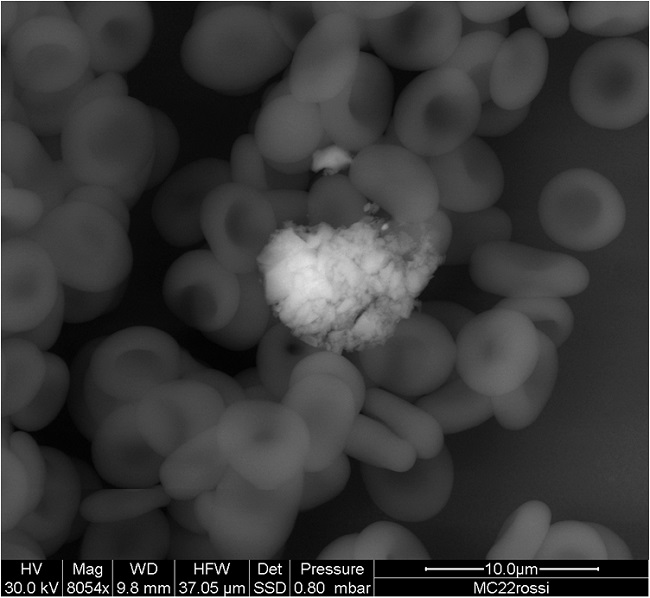Nanotoxicology and Particle Toxicology
 Nanotoxicology and Particle Toxicology: An Interview with Dr. Antonietta Gatti
Nanotoxicology and Particle Toxicology: An Interview with Dr. Antonietta Gatti
Interview conducted by Alexander Chilton
Dr. Antonietta Gatti, Scientific Director of Nanodiagnostics, talked to AZoNano about her new book 'Case Studies in Nanotoxicology and Particle Toxicology' published by Elsevier Academic Press, 2015.
AC: Could you provide our readers with a summary of how you
became involved in the fields of nanotoxicology and particle toxicology?
AG: It’s a very long story that I will try to
summarize as much as I can. At the beginning of the 90s, when I was the
director of the Laboratory of Biomaterials of the University of Modena, a
laboratory I had founded years before, my husband, Dr. Stefano Montanari,
brought me a caval filter, a small device which is implanted in the
inferior vena cava to prevent pulmonary thrombo-embolism. That filter
had broken in vivo, had been explanted from the patient and the surgeon,
a friend of my husband’s, wished to know why that device had failed(...)
After that, our story became more complicated, but what is important
is that in 2002 the European Community put me in charge of a research
project called Nanopathology. In that contest, together with a few
partners among which the universities of Mainz and Cambridge, I could
research much more in depth the phenomenon of solid micro- and
nanoparticles entering the organism and causing a series of conditions I
called nanopathologies, since their common origin was from micro- and
nanoparticles.
Then, for a number of reasons, in the year 2004 my husband and I
founded the laboratory Nanodiagnostics where we are still working. One
year after, the European Commission put me in charge of another research
project called DIPNA based on nano-eco-toxicology, i.e. the
toxicological effects of very small particles.

An-vivo image of a cluster of nanoparticles surrounded human red blood cells of a person exposed to pollution.
AC: Could you summarise the current activity which is taking place within the field of Nanodiagnostics?
AG: We keep researching into solid, inorganic micro-
and nanoparticles and the pathologies they induce. They can enter the
organism mainly via inhalation and ingestion. If they are small enough,
and they often are, they reach the pulmonary alveoli and, within a few
tens of seconds, they enter the blood circulation. There, in a minority
of subjects, they make the blood clot, thus causing pulmonary
thrombo-embolism if the phenomenon occurs in the veins, stroke and
infarction if it occurs in the arteries.
In most cases, the blood carries the particles virtually to any
organ, and, no matter what the organ is, it behaves like a filter,
capturing the particles without any possibility for them to be released
or somehow eliminated. As happens with any small foreign body, those
particles induce the formation of an inflammatory tissue that becomes
chronic and, in the long run, can turn to a cancer. But particles can
also cause diseases of the nervous system when they are captured by the
brain or, when they interest other organs, probably hard-to-suspect
pathologies like, for example, type-1 diabetes if their target has been
the pancreas(...)
About Dr. Antonietta Gatti
Dr. Antonietta Gatti
has an interdisciplinary background that ranges from physics,
chemistry, biology, physiology and pathology. Dr. Gatti has 40 years of
research experience in the field of biomaterials and biocompatibility at
national and international levels in various capacities.
In 2002, Dr. Gatti was appointed as the coordinator of the European
project called Nanopathology through which a new diagnostic tool was
developed. The results of the project are described in her book
Nanopathology, published by Pan Stanford Publishing (Singapore).
Dr. Gatti used scanning electron microscopy to identify nanoparticles
in biological samples, organic matrices, in food, in water and in
plants. The experience of Nanopathology led to a further European
project called DIPNA (Nanotoxicology), to the Italian Projects BATNAN,
INESE and VENAM of nanoecotoxicity.
Dr. Gatti is the author of about 210 articles in peer reviewed
journals. She created the Laboratory of Biomaterials at the University
of Modena. Currently she is a European authority in the fields of
nanopathology (the human and animal pathologies triggered by micro and
nanoparticles), nanotoxicology, nanoecotoxicology and environmental
pollution.
UPLOADED BY inFÁRMAte

Comentarios
Publicar un comentario